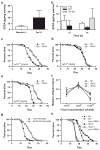N-acylethanolamine signalling mediates the effect of diet on lifespan in Caenorhabditis elegans
- PMID: 21562563
- PMCID: PMC3093655
- DOI: 10.1038/nature10007
N-acylethanolamine signalling mediates the effect of diet on lifespan in Caenorhabditis elegans
Abstract
Dietary restriction is a robust means of extending adult lifespan and postponing age-related disease in many species, including yeast, nematode worms, flies and rodents. Studies of the genetic requirements for lifespan extension by dietary restriction in the nematode Caenorhabditis elegans have implicated a number of key molecules in this process, including the nutrient-sensing target of rapamycin (TOR) pathway and the Foxa transcription factor PHA-4 (ref. 7). However, little is known about the metabolic signals that coordinate the organismal response to dietary restriction and maintain homeostasis when nutrients are limited. The endocannabinoid system is an excellent candidate for such a role given its involvement in regulating nutrient intake and energy balance. Despite this, a direct role for endocannabinoid signalling in dietary restriction or lifespan determination has yet to be demonstrated, in part due to the apparent absence of endocannabinoid signalling pathways in model organisms that are amenable to lifespan analysis. N-acylethanolamines (NAEs) are lipid-derived signalling molecules, which include the mammalian endocannabinoid arachidonoyl ethanolamide. Here we identify NAEs in C. elegans, show that NAE abundance is reduced under dietary restriction and that NAE deficiency is sufficient to extend lifespan through a dietary restriction mechanism requiring PHA-4. Conversely, dietary supplementation with the nematode NAE eicosapentaenoyl ethanolamide not only inhibits dietary-restriction-induced lifespan extension in wild-type worms, but also suppresses lifespan extension in a TOR pathway mutant. This demonstrates a role for NAE signalling in ageing and indicates that NAEs represent a signal that coordinates nutrient status with metabolic changes that ultimately determine lifespan.
Conflict of interest statement
The authors declare no competing financial interests.
Figures




Comment in
-
Cell signalling: why fasting worms age slowly.Nature. 2011 May 12;473(7346):161-3. doi: 10.1038/473161a. Nature. 2011. PMID: 21562553 No abstract available.
References
-
- Mair W, Dillin A. Aging and survival: the genetics of life span extension by dietary restriction. Annu Rev Biochem. 2008;77:727–754. - PubMed
-
- Bishop NA, Guarente L. Genetic links between diet and lifespan: shared mechanisms from yeast to humans. Nat Rev Genet. 2007;8:835–844. - PubMed
-
- Honjoh S, Yamamoto T, Uno M, Nishida E. Signalling through RHEB-1 mediates intermittent fasting-induced longevity in C. elegans. Nature. 2009;457:726–730. - PubMed
-
- Bishop NA, Guarente L. Two neurons mediate diet-restriction-induced longevity in C. elegans. Nature. 2007;447:545–549. - PubMed
Publication types
MeSH terms
Substances
Grants and funding
LinkOut - more resources
Full Text Sources
Other Literature Sources

